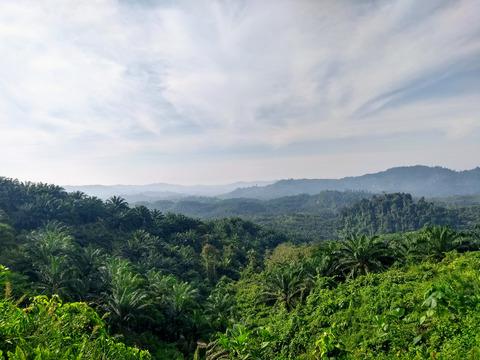当前位置:
X-MOL 学术
›
Funct. Ecol.
›
论文详情
Our official English website, www.x-mol.net, welcomes your feedback! (Note: you will need to create a separate account there.)
Trait filtering during exotic plant invasion of tropical rainforest remnants along a disturbance gradient
Functional Ecology ( IF 5.2 ) Pub Date : 2020-09-12 , DOI: 10.1111/1365-2435.13679 Emily H. Waddell 1, 2, 3 , Daniel S. Chapman 1, 4 , Jane K. Hill 2 , Mark Hughes 3 , Azlin Bin Sailim 5 , Joseph Tangah 6 , Lindsay F. Banin 1
中文翻译:

沿干扰梯度外来植物入侵热带雨林残余物中的性状过滤
更新日期:2020-09-12
Functional Ecology ( IF 5.2 ) Pub Date : 2020-09-12 , DOI: 10.1111/1365-2435.13679 Emily H. Waddell 1, 2, 3 , Daniel S. Chapman 1, 4 , Jane K. Hill 2 , Mark Hughes 3 , Azlin Bin Sailim 5 , Joseph Tangah 6 , Lindsay F. Banin 1
Affiliation

|
- Human‐modified tropical landscapes are often invaded by exotic plant species, but relatively few species are able to colonise remnant areas of rainforest embedded within such landscapes. The functional traits of successful invaders of natural versus anthropogenic habitats are poorly known, especially in tropical regions, and identifying such traits provides insight into the mechanisms that drive invasion. Here, we examine the invasion of tropical rainforest remnants along a disturbance gradient, within a human‐modified agricultural landscape, and determine whether exotic species that invade these forests are selected according to particular traits.
- We surveyed the occurrence of 18 exotic species along 100‐m transects in four habitats—oil palm road, forest‐oil palm edges and disturbed and intact forest within rainforest remnants—at 21 sites across Sabah, Malaysian Borneo. We collated data on four functional traits relevant to the barriers plants encounter when colonising new environments (e.g. dispersal and persistence) and tested whether trait filtering occurs during invasion of rainforest remnants.
- Exotic species richness declined significantly from oil palm (mean 9.2 species per transect) to forest edge (7.8 species) to inside rainforest remnants (3.1 species in disturbed forest), and only one species, Clidemia hirta, invaded intact forest. Exotic communities within rainforest remnants had long‐distance (vertebrate) dispersal, were woodier and had taller maximum heights, compared to those found in oil palm. For each trait, the community‐weighted mean for the forest edge community was intermediate between oil palm and disturbed forest, suggesting trait filtering during the invasion of rainforest remnants.
- Our study provides strong evidence that trait filtering occurs during invasion from human‐modified agricultural habitats into previously disturbed forests via the forest edge. Successful invasion of rainforest remnants requires relatively long‐distance dispersal, in particular by vertebrates, as well as traits that are more similar to those of native forest species (i.e. tall and woody), making these exotic species more able to compete and persist in that environment. Our results show that disturbed tropical rainforests with open canopies are susceptible to invasion and highlight the traits of exotic species which can invade rainforest habitats, and which may pose a threat to regenerating tropical rainforests.
中文翻译:

沿干扰梯度外来植物入侵热带雨林残余物中的性状过滤
- 人为改造的热带景观通常会受到外来植物物种的入侵,但是能够在这些景观中埋藏的雨林残余区域定居的物种相对较少。对于自然和人为生境的成功入侵者的功能性状知之甚少,尤其是在热带地区,而识别出这些特征可以深入了解驱动入侵的机制。在这里,我们研究了人类改良的农业景观内热带雨林残余物沿干扰梯度的入侵,并确定是否根据特定特征选择了入侵这些森林的外来物种。
- 我们在马来西亚婆罗洲的沙巴州的21个地点调查了四个生境(油棕道路,林油棕边缘和热带雨林残余内受干扰和完整的森林)沿100米横断面的18种外来物种的发生情况。我们整理了与植物在新环境中定殖时遇到的障碍相关的四个功能性状的数据(例如,分散性和持久性),并测试了性状过滤是否在雨林残余物入侵期间发生。
- 从油棕(每个样带平均9.2种)到森林边缘(7.8种)再到热带雨林残余物(受干扰的森林中有3.1种),外来物种的丰富度显着下降,只有一种物种Clidemia hirta入侵了完整森林。与在油棕中发现的外来群落相比,雨林残余物中的外来群落具有长距离(脊椎动物)的扩散,木质度更高,最大高度更高。对于每个特征,森林边缘群落的群落加权平均值介于油棕和受干扰的森林之间,这表明在雨林残余物入侵期间特征过滤。
- 我们的研究提供了有力的证据,表明在从人类改良的农业生境通过森林边缘侵入先前受干扰的森林的入侵过程中,发生了特征过滤。成功入侵雨林残余物需要相对长距离的扩散,尤其是脊椎动物的扩散,以及与原生森林物种(即高大和木质)的特征更加相似的特征,从而使这些外来物种更能够竞争并持久存在环境。我们的研究结果表明,带有遮盖的热带雨林很容易受到入侵,并突出了可以入侵雨林栖息地的外来物种的特征,并可能威胁到热带雨林的更新。



























 京公网安备 11010802027423号
京公网安备 11010802027423号